
The long jump is a track and field event in which athletes combine speed, strength and agility in an attempt to leap as far as possible from a takeoff point. Along with the triple jump, the two events that measure jumping for distance as a group are referred to as the "horizontal jumps". This event has a history in the ancient Olympic Games and has been a modern Olympic event for men since the first Olympics in 1896 and for women since 1948.

Athletics is a group of sporting events that involves competitive running, jumping, throwing, and walking. The most common types of athletics competitions are track and field, road running, cross-country running, and racewalking.
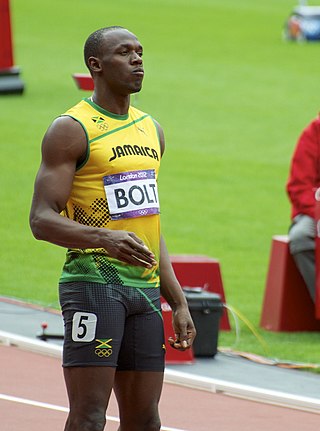
Sprinting is running over a short distance at the top-most speed of the body in a limited period of time. It is used in many sports that incorporate running, typically as a way of quickly reaching a target or goal, or avoiding or catching an opponent. Human physiology dictates that a runner's near-top speed cannot be maintained for more than 30–35 seconds due to the depletion of phosphocreatine stores in muscles, and perhaps secondarily to excessive metabolic acidosis as a result of anaerobic glycolysis.

Track and field is a sport that includes athletic contests based on running, jumping, and throwing skills. The name is derived from where the sport takes place, a running track and a grass field for the throwing and some of the jumping events. Track and field is categorized under the umbrella sport of athletics, which also includes road running, cross country running and racewalking. In British English the term "Athletics" is synonymous with American "Track and Field" and includes all jumping events.

Cross country running is a sport in which teams and individuals run a race on open-air courses over natural terrain such as dirt or grass. The course, typically 3–12 kilometres (1.9–7.5 mi) long, may include surfaces of grass and earth, pass through woodlands and open country, and include hills, flat ground and sometimes gravel road and minor obstacles. It is both an individual and a team sport; runners are judged on individual times and teams by a points-scoring method. Both men and women of all ages compete in cross country, which usually takes place during autumn and winter, and can include weather conditions of rain, sleet, snow or hail, and a wide range of temperatures.

The 400 metres hurdles is a track and field hurdling event. The event has been on the Olympic athletics programme since 1900 for men and since 1984 for women.

Weltklasse Zürich is an annual, invitation-only, world-class track and field meeting at the Letzigrund in Zürich, Switzerland, generally held at the end of August or beginning of September. Previously one of the IAAF Golden League events, it now serves as a final of the Wanda Diamond League, alongside Memorial Van Damme between 2010 and 2019. In 2021, Welklasse Zürich will serve as the sole final of the Diamond League. One of the first large-scale international athletics events, it is sometimes referred to as the one-day Olympics. Weltklasse Zürich first took place on 12 August 1928. In the beginning, the meeting was nicknamed by the public the "Nurmi meeting" after the most admired and celebrated participant at the time, Paavo Nurmi. On 21 June 1960, on the Letzigrund track, Armin Hary became the first human to run the 100 m dash in 10.0 seconds.

Drake Stadium is a stadium on the campus of Drake University in Des Moines, Iowa, United States. Best known as the home of the Drake Relays, it also serves as the home field of the university's football team. It opened in 1925.

Tartan Track is a trademarked all-weather synthetic track surfacing made of polyurethane used for track and field competitions, manufactured by 3M. The original production was in 1967, and the product was later reformulated to eliminate the use of mercury. Relative to some other surfaces, it lets athletes compete in bad weather without serious performance loss and improves their results over other surfaces. It also provides a more consistent surface for competition even under optimum weather. Similar tracks have become the standard for most elite competitions.
Spec Towns Track is the track and field facility and stadium for the University of Georgia (UGA) in Athens, Georgia. The track was originally built in 1964 and the stadium grandstand was added in 1987 to accommodate 1,000 spectators. In 2011, the Bulldogs hosted their first Southeastern Conference Outdoor Track & Field Championships since 1999 at the Spec Towns Track. Following the 2017 track season, the track was upgraded to a 400-meter, 8-lane Mondo Sportflex Super X720 surface, replacing the old polyurethane track.
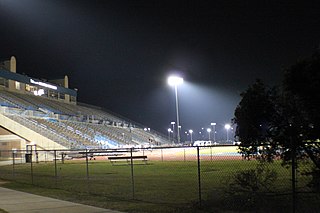
Hodges Stadium is a multi-purpose stadium at the University of North Florida (UNF), and the home field for the North Florida Ospreys soccer, track and field, and cross country teams. It is located on the university's campus in Jacksonville, Florida, U.S. It is named for George and Kernan Hodges, who donated $2 million to upgrade the facility in 2006.
John McDonnell Field is the outdoor track facility at the University of Arkansas in Fayetteville, Arkansas, and is home to the Arkansas Razorbacks. The field is named after former head coach John McDonnell, who ended his thirty-six-year collegiate head coaching career as the most successful coach in NCAA track history, attaining a total of 42 NCAA Championships in three different sports with the Razorbacks. Renovated in 2006, it is one of only ten International Association of Athletics Federations Class 1 certified tracks in the United States.
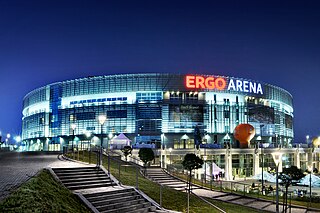
Ergo Arena is a multi-purpose indoor arena, that was opened in 2010. The boundary between two cities – Sopot and Gdańsk – runs through the very middle of the hall. The arena has a capacity of 11,409 people, for sports events and up to 15,000, with standing places, for concerts.
Beynon Sports Surfaces is a manufacturer and installer of synthetic all-weather running tracks. They are part of Tarkett Sports and are based in Hunt Valley, Maryland. Beynon Sports Surfaces manufactures three types of outdoor synthetic athletic tracks; spray coat, sandwich and full pour polyurethane. They also offer surfaces for fieldhouses and gymnasiums.

The 2014 IAAF World Indoor Championships in Athletics was the fifteenth edition of the international indoor track and field competition, organised by the IAAF. The event was held between 7–9 March 2014 at the Ergo Arena in Sopot, Poland.

Athletics at the 2020 Summer Olympics were held during the last ten days of the Games. They were due to be held from 31 July – 9 August 2020, at the Olympic Stadium in Tokyo, Japan. Due to the COVID-19 pandemic, the games were postponed to 2021, with the track and field events set for 30 July – 8 August. The sport of athletics at these Games was split into three distinct sets of events: track and field events, remaining in Tokyo, and road running events and racewalking events, moved to Sapporo. A total of 48 events were held, one more than in 2016, with the addition of a mixed relay event.
Mondo S.p.A. is an Italian company best known for manufacturing and installing track and field and other athletic surfaces. The company was founded in 1948 in Alba, Piedmont by Edmondo Giovanni Stroppiana, who used part of his name to name the organization. Mondo has supplied track and field surfaces for the last ten Olympic Games. The company also produces commercial rubber flooring for schools, hospitals, office buildings, and more.
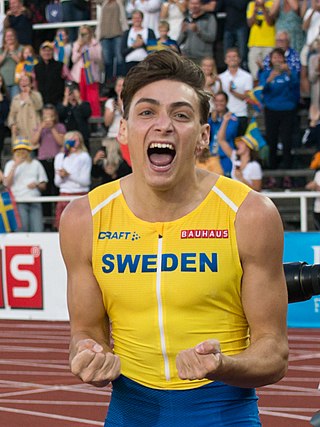
Armand Gustav "Mondo" Duplantis is a Swedish-American pole vaulter, the current world outdoor and indoor record holder, the current Olympic and two time World outdoor and one-time indoor champion, the current European champion, and the current Diamond League champion. He won the silver medal at the 2019 World Championships. Duplantis is a two-time European champion from 2018, when he set current world under-20 record, and from 2022. Indoors, he is 2022 World Indoor Championship and 2021 European Indoor Championship gold medallist.

Michael Arthur Norman Jr. is an American sprinter. He holds the world best time in the indoor 400 meters at 44.52 seconds. Outdoors, his 43.45, set at the 2019 Mt. SAC Relays is tied as the #4 on the all time list. In 2016, he became the world junior champion in both the 200 meters and 4×100 meter relay. In 2022, he became the world champion in both the 400 meters and 4x400 meter relay.
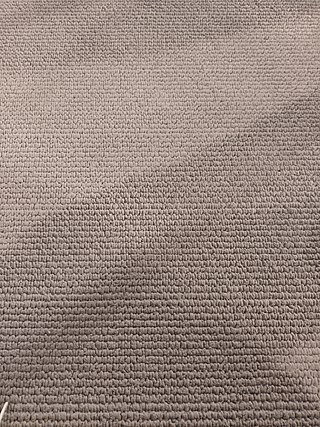
Mondotrack is a trademarked synthetic track surface used for Track and field athletics. Mondotrack is developed by Mondo, a world leader in Track and field surfacing. Research was done to achieve the best possible surface for track events that will enhance performance and decrease the chance of injury. All Mondotracks come with a woven top layer and a hexagonal base layer. Unlike other tracks, Mondotracks can be different colors. Mondotracks are very prominent around the world.

















